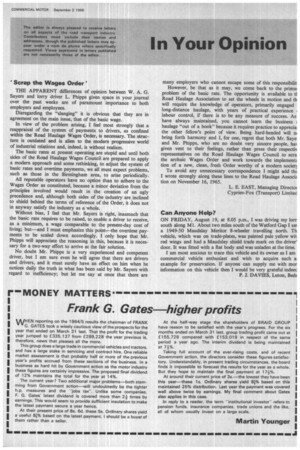Frank G. Gates higher profits
Page 75

If you've noticed an error in this article please click here to report it so we can fix it.
WHEN reporting on the 1964/5 results the chairman of FRANK G. GATES took a wisely cautious view of the prospects for the year that ended on March 31 last. That the profit for the trading year jumped to £335,137 from £289,228 the year previous is, therefore, news that pleases all the more.
This group does a large trade in commercial vehicles and tractors, and has a large stake in servicing and contract hire. One reliable market assessment is that probably half or more of the previous year's profits accrued from these sections of the business. In a business as hard hit by Government action as the motor industry these figures are certainly impressive. The proposed final dividend of 12% maintains the total for the year at 14%.
The current year? Two additional major problems—both stemming from Government action—will undoubtedly be the tighter h.p. measures and the "jobs tax". Unlike some companies, F. G. Gates' latest dividend is covered more than 2+ times by earnings. This would seem to provide sufficient insulation to make the latest payment secure a year hence.
At their present price of 8s. 6d. these 5s. Ordinary shares yield a useful based on the latest payment. I should be a buyer of them rather than a seller, At the half-way stage the shareholders of BRAID GROUP have reason to be satisfied with the year's progress. For the six months ended on March 31 last, group trading profit came out at £155,728 compared with £153.019 in respect of the same period a year ago. The interim dividend is being maintained at 71%.
Taking full account of the ever-rising costs, and of recent Government action, the directors consider these figures satisfactory. Understandably, in present trading circumstances, the board finds it impossible to forecast the results for the year as a whole. But they hope to maintain the final payment at 17+%.
At around their current price of 3s.—the lowest they have been this year—these 1s. Ordinary shares yield 8% based on this maintained 25% distribution, Last year the payment was covered well above twice by earnings. My final comment about Gates also applies in this case.
In reply to a reader, the term "institutional investor" refers to pension funds, insurance companies, trade unions and the like, all of whom usually invest on a large scale.
Martin Younger
































































































































